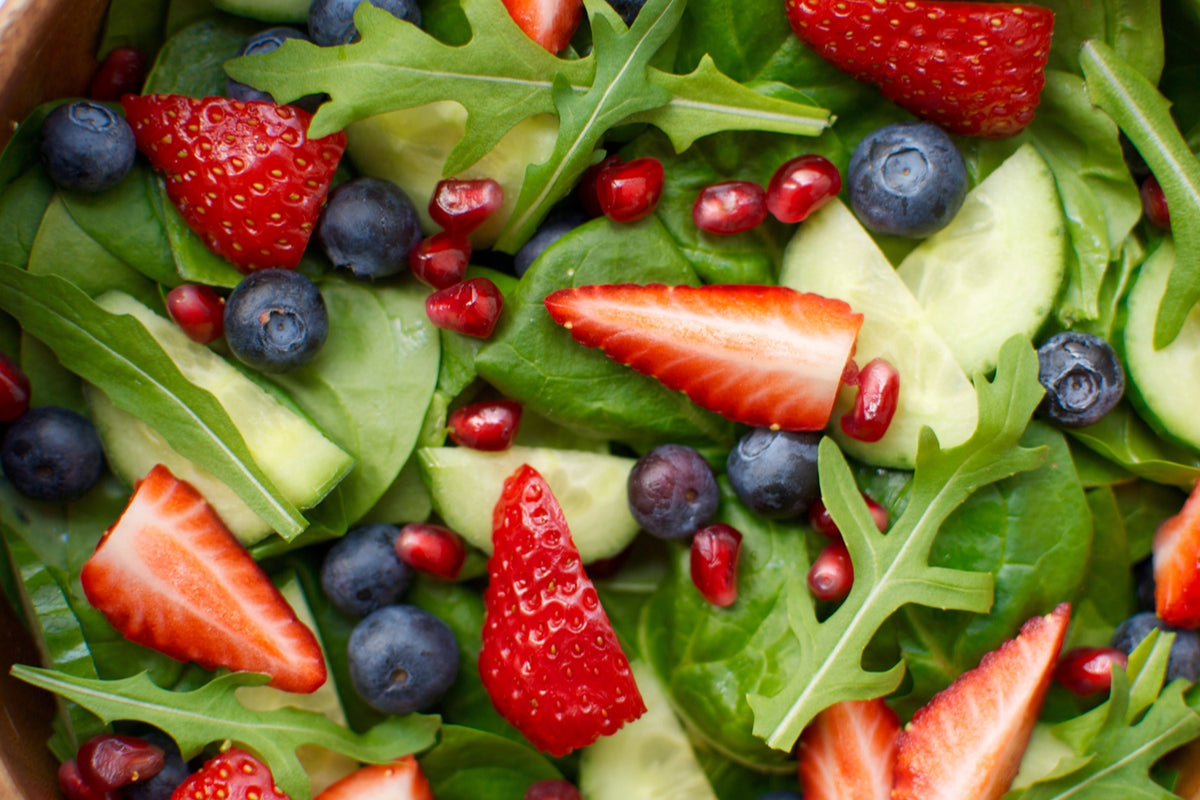
Quick Take
Struggling with high blood sugar? It may be time to add more plants to your plate. With a whole food plant-based (or WFPB) diet, you are not only getting natural sugars you need for energy and optimal health, but you are also eating other important compounds such as fiber, water, and phytonutrients that naturally regulate how sugar is absorbed by the body. You don’t have to suffer from lethargy, headaches, and brain fog — eating WFPB options like whole fruits and veggies can naturally lower your blood sugar!
Before We Begin: Get WFPB Snacks and Superfoods. Snack Variety Bundle. No Processed Sugars, No Oils.
On this Page
What Is Sugar and Why Does Our Body Need It?
Plant-Based Diet and Diabetes: What's the Connection?
Blood Sugar and Health
The Foods to Avoid for Lower Blood Sugar Levels
Key Takeaways
What Is Sugar and Why Does Our Body Need It?
Yep! Your body needs sugar. But not all sugar is created equally.
The body uses simple sugars, carbohydrates fructose and glucose, to create and store energy so it can keep us healthy and vital. When we eat an apple, for example, all the components of the apple are broken down and the sugar glucose is shuttled by insulin to cells so that they can convert it to ATP (energy!).
The metabolism of fructose (or fruit sugar), doesn’t depend on insulin. Instead, fructose is gradually converted to glucose in the gut, preventing insulin malfunction and blood sugar spikes.
Plant-Based Diet and Diabetes: What's the Connection?
People with hyperglycemia and diabetic conditions can benefit greatly from whole foods that contain fructose because there is a smaller risk in experiencing insulin-related blood sugar issues.
However, eating whole plant foods is very important in maintaining a healthy blood sugar level. A plant based diet has been shown to not only prevent, but also reverse, type 2 diabetes!
Without the natural buffering components in whole plants (like fiber!), eating processed sugars such as high-fructose corn syrup and table sugar can lead to many symptoms associated with hyperglycemia and diabetes, including lethargy, weakness, ungroundedness, headaches, mood swings, and brain fog.
Blood Sugar and Health
Maintaining healthy blood sugar levels is a key component to your overall health — whether you have diabetes or not!
When glucose accumulates in the bloodstream for long periods of time, the pancreas tries to process it by making extra insulin. Over time, the pancreas is so overtaxed it stops producing insulin, leaving the body unable to control blood sugar levels and use glucose for energy.
Eating processed sugar and high fat foods (common in the Standard American Diet) can create blood sugar problems by interfering with insulin production and utilization.
Because balanced blood sugar is essential to our well-being, it is important to know which foods can help us balance our blood sugar levels so that we can feel energized and ready to enjoy life.
The 5 Best WFPB Foods for Lowering Blood Sugar Levels Naturally
1. Berries

Think there's too much sugar in fruit? Well, the fructose in whole fruit is different from the sugar found in processed foods and doesn't cause the same blood sugar spikes and dips.
Actually, eating fruit may protect you from blood sugar spikes, especially if you're eating berries.
Fruits contain simple sugars fructose and glucose which work together with other components of fruit such as phytonutrients, fiber, and water to regulate blood sugar levels and keep our body clean and healthy. Because we are usually not able to eat too much fruit (it is hydrating, sweet, and very filling), we are unlikely to experience insulin issues even if fruit is prominent in our WFPB diet.
People with preexisting blood sugar conditions and those who are uncertain how they will react to fruit sugars can avoid overripe fruit and choose lower glycemic load fruit such as most berries.
2. Leafy Greens

Most non-starchy vegetables, especially the leafy greens, have a very low glycemic load.
Veggies tend to be higher in glucose and lower in fructose, but they are loaded with fiber and many powerful phytonutrients, such as chlorophyll, which helps glucose slowly enter the bloodstream. Chlorophyll in leafy greens also calms the nervous system down, preventing that sugar “high” we can experience with higher than optimal blood sugar.
Because we don’t usually overeat vegetables, especially in their raw form, we run a very low risk of encountering blood sugar problems while eating them, even with starchier veggies that are higher in glucose!
3. Oatmeal

The idea of carbs causing diabetes isn't exactly true. Insulin resistance is often by caused is too much fat in the bloodstream — not from eating whole carbohydrates that are included in a. WFPB diet.
Sure, refined carbs, like those found in processed and packaged foods, are stripped of their fiber and nutrients and can cause blood sugar spike sand drops.
But whole grain consumption, like eating a healthy bowl of oats, has been shown to reduce risk for type 2 diabetes!
4. Lentils

Lentils really are a WFPB superfood. They're immunity-boosting, keep us satisfied, they even lift our mood! No wonder lentils are prominent in some of the favorite cuisines of the world (Dhal, anyone?) With a wonderful range of colors, textures, and flavors, you can never get bored with these legumes.They are also quick and easy to make and only require rinsing before cooking.
And when it comes to your blood sugar, lentils are a great choice. They are very high in fiber which helps slow down the absorption of glucose in the gut.
6. Cinnamon (and Other Herbs and Spices)

Why not add more flavor, aroma, nutrients, and healing compounds to your meals? It turns out, certain herbs and spices can further enhance the blood sugar-balancing capabilities of the food they are combined with.
Cinnamon, in particular, is a healthy choice for your blood sugar. It's the most-tested spice for its effects on blood sugar levels and has been shown to significantly lower the post-meal glucose response in type 2 diabetes patients.
Need some cinnamon inspiration? Try this WFPB cinnamon chocolate shake!
Other good herbs and spices to add to your cooking to reduce blood sugar naturally:
-
Oregano
-
Sage
-
Rosemary
-
Thyme
-
Cloves
-
Turmeric
-
Ginger
The Foods to Avoid for Lower Blood Sugar Levels
1. Highly Processed Grains
I get it — pasta is delicious! But white pasta and bread are hard on our digestion and blood sugar balance.
When grains are processed, the husks (and therefore the fiber) is stripped away from the kernels. The grain is further ground and bleached, leaving it devoid of most nutrients while concentrating gluten and glucose. Without all the helpful components to slow down glucose absorption in the gut, we can experience unpredictable spikes in blood sugar.
Not to mention the low nutrition content makes us crave more white pasta and bread, leading to weight gain, lethargy, gut healthy issues, and other problems.
2. Refined Sugars
We already covered the importance of natural sugar on your body's well-being. But refined sugars can be harmful for blood sugar levels, and your health.
Highly processed and/or refined sugars (table sugar and high-fructose corn syrup, for example), are devoid of fiber, most nutrients, and tend to have very high concentrations of sucrose and glucose. Our body treats this onslaught of sugar as poison since these refined substances cannot be ideally processed by the body. This causes high blood sugar and related health problems.
Luckily, there are some delicious healthy alternatives to highly-processed sugars so you can satiate your sweet tooth AND keep your blood sugar in check.
3. High Fat Foods
A diet high in fatty foods (like the Standard American diet) can cause that excess fat to build up in our cells, which messed with insulin's ability to move glucose out of our bloodstream and into our muscle cells, and can eventually lead to type 2 diabetes.
When you cut out fatty foods and move to a more WFPB diet, you can move your blood sugar in the right direction.
Key Takeaways
- Glucose and fructose are simple sugar carbohydrates found in plants which help our cells create energy and facilitate optimal body function.
- A WFPB diet is ideal for maintaining healthy blood sugar levels because whole foods have many blood sugar-regulating compounds that aid in balanced absorption of sugar by the body.
- Choosing whole foods that are high in fiber, with their nutrients in tact, can help us maintain a healthy blood sugar level.
**
By Sebila Kratovac
Sebila is very passionate about plant-based food and how it can help us heal from the inside out. You can often find her creating new vegan dishes and infusing them with healing herbs and spices or just enjoying being in nature. She is also an ardent artist, dancer, performer, writer, and wellness practitioner.

